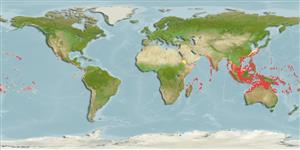Teleostei (teleosts) >
Eupercaria/misc (Various families in series Eupercaria) >
Labridae (Wrasses) > Cheilininae
Etymology: Oxycheilinus: Greek, oxys = sharp + Greek, cheilos = lip.
More on author: Valenciennes.
Environment: milieu / climate zone / depth range / distribution range
Ecology
Marine; reef-associated; depth range 2 - 120 m (Ref. 1602). Tropical; 32°N - 21°S
Indo-Pacific: East Africa to the Hawaiian and Marquesan islands, north to southern Japan, south to Vanuatu.
Size / Weight / Age
Maturity: Lm ? range ? - ? cm
Max length : 16.4 cm TL male/unsexed; (Ref. 26178)
Dorsal
spines
(total): 9;
Dorsal
soft rays
(total): 10-11;
Anal
spines: 3;
Anal
soft rays: 8. Body variable from brown to yellow or green mixed with various color shades or spots. Males develop long filaments on the caudal fin (Ref. 48636). Young with a broad, dark lateral stripe which breaks into dark blotches in adults, the largest above distal pectoral fins. A small dark spot behind eye. Mouth terminal or lower jaw slightly projecting. Caudal fin of terminal males rhomboid, with central rays longest, and dorsalmost caudal-fin ray elongated into a short filament. A small species (reaching about 14 cm) (Ref 9823).
Inhabits outer reef slopes or deep clear lagoons among rubble or clumps of algae; also in seagrass beds (Ref. 1602, 41878, 58302). Often in sheltered estuaries and harbors (Ref. 48636). Benthic and benthopelagic (Ref. 58302). Maximum depth reported taken from Ref. 128797.
Life cycle and mating behavior
Maturity | Reproduction | Spawning | Eggs | Fecundity | Larvae
Oviparous, distinct pairing during breeding (Ref. 205).
Westneat, M.W., 1993. Phylogenetic relationships of the tribe Cheilinini (Labridae: Perciformes). Bull. Mar. Sci. 52(1):351-394. (Ref. 7441)
IUCN Red List Status (Ref. 130435)
Threat to humans
Harmless
Human uses
Fisheries: subsistence fisheries; aquarium: commercial
More information
ReferencesAquacultureAquaculture profileStrainsGeneticsElectrophoresesHeritabilityDiseasesProcessingNutrientsMass conversion
Tools
Special reports
Download XML
Internet sources
Estimates based on models
Preferred temperature (Ref.
123201): 25.2 - 29, mean 28 °C (based on 1414 cells).
Phylogenetic diversity index (Ref.
82804): PD
50 = 0.5020 [Uniqueness, from 0.5 = low to 2.0 = high].
Bayesian length-weight: a=0.01905 (0.01144 - 0.03173), b=2.77 (2.63 - 2.91), in cm total length, based on LWR estimates for this species & (Sub)family-body (Ref.
93245).
Trophic level (Ref.
69278): 3.5 ±0.57 se; based on food items.
Resilience (Ref.
120179): High, minimum population doubling time less than 15 months (Preliminary K or Fecundity.).
Fishing Vulnerability (Ref.
59153): Low vulnerability (10 of 100).
Nutrients (Ref.
124155): Calcium = 86.7 [31.2, 205.4] mg/100g; Iron = 0.884 [0.331, 2.088] mg/100g; Protein = 18.4 [15.5, 20.6] %; Omega3 = 0.174 [0.087, 0.348] g/100g; Selenium = 32.7 [12.3, 99.6] μg/100g; VitaminA = 140 [43, 534] μg/100g; Zinc = 2.24 [0.97, 3.91] mg/100g (wet weight);
